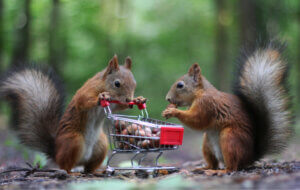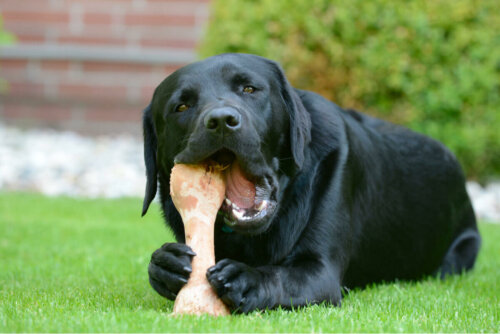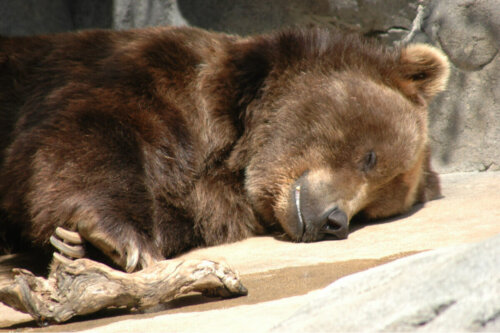Animals That Store Food: What's Behind This Behavior?


Written and verified by the vet Érica Terrón González
There are many animals that store food for times of need, such as winter, the breeding season, or droughts. To do this, they carefully hide food from other animals in all sorts of different places.
These animals usually feed on seeds or fruits, meaning they are herbivores. However, there are species with more varied, omnivorous diets. As surprising as it may seem, there are even some carnivores who are experts at storing food for later.
Animals that store food
Why do animals need to gather food? We’ll explain it to you below.
Being proactive
In most cases, this storage behavior is a result of survival instincts. It’s a way of saving food when there’s a surplus to consume later when food is scarce. Typically, they store food in a makeshift “pantry” adapted to several factors:
- Possible seasonal changes.
- The presence of competing animals in the same territory.
- In regions with harsh winters, for example, storing food provides a significant survival advantage.
In the animal kingdom, it’s important to differentiate between true food storage versus other behavior patterns. An animal in the wild is used to periods when food is scarce so they start gathering and storing resources.
However, domestic dogs will bury bones and toys without any real need. Why do they do this? Once again, it’s about survival instinct. Don’t forget that their ancestors didn’t have the luxury of people feeding them regularly. Storing food is burned into their DNA.

Good things come to those who wait
In most cases, the animal will try to create a ready-to-eat food reserve for an uncertain future. However, species are known to allow food to mature in their storage location. For example, animals will keep food that isn’t ripe yet, knowing that it will be edible after a while.
- One example is the tayra (Eira Barbara), which hides green bananas and comes back to eat them later once they’ve ripened.
- Alligators can bite into prey, but they can’t actually tear off meat and chew it. As a result, if the prey is small, the alligator will swallow it whole. However, if it’s very large, they’ll store it underwater and allow it to rot (or ripen) so they can eat it more easily.
- Also, insects, such as ants, let some food mature. For example, some species of ants harvest pieces of inedible leaves and then store them underground. Stored together with fungi, these leaves mature and can help feed the colony.
Examples of animals that store food
Most of the storage animals are rodents. For example, squirrels are very far-sighted when faced with possible future shortages. That’s why they hide nuts, hazelnuts, and seeds in different hiding places for when the cold arrives. The problem is that they often forget where their pantry is. The good thing about this mistake is that buried seeds or fruits later germinate and grow into trees.
However, there are also storage species among birds. This is the case of the shrike or butcher bird, which is known to hunt insects, birds, reptiles, or mammals and impale their bodies on thorny stems. This serves as food stores to feed their chicks without having to go hunting again.
Other ways animals prepare for times of scarcity
Animals do many different things to survive in the winter, in addition to storing food:
- Some migrate to other places where the climate is warmer and they can find food more easily. This is the case for many birds that travel in flocks, to reduce the dangers of such a long journey.
- Other animals hibernate for part of the winter. Hibernating is falling into a special sleep, which is deeper than normal. During this sleep, body temperature, heart rate, and respiration all decrease until they are imperceptible. Before it’s time to hibernate, these animals prepare by eating extra food and storing it as body fat.
- Alternatively, some animals remain active during the winter, but they make adaptations prior to the arrival of colder weather. For example, this might mean changes in their eating behavior or in their bodies, such as generating new and thicker skin.

As we’ve seen, many animals have food storage techniques for harder times embedded in their genetic code. This strategy is about an exchange of energy since they invest their own energy in storing food in order to have plenty of food in more difficult times.
There are many animals that store food for times of need, such as winter, the breeding season, or droughts. To do this, they carefully hide food from other animals in all sorts of different places.
These animals usually feed on seeds or fruits, meaning they are herbivores. However, there are species with more varied, omnivorous diets. As surprising as it may seem, there are even some carnivores who are experts at storing food for later.
Animals that store food
Why do animals need to gather food? We’ll explain it to you below.
Being proactive
In most cases, this storage behavior is a result of survival instincts. It’s a way of saving food when there’s a surplus to consume later when food is scarce. Typically, they store food in a makeshift “pantry” adapted to several factors:
- Possible seasonal changes.
- The presence of competing animals in the same territory.
- In regions with harsh winters, for example, storing food provides a significant survival advantage.
In the animal kingdom, it’s important to differentiate between true food storage versus other behavior patterns. An animal in the wild is used to periods when food is scarce so they start gathering and storing resources.
However, domestic dogs will bury bones and toys without any real need. Why do they do this? Once again, it’s about survival instinct. Don’t forget that their ancestors didn’t have the luxury of people feeding them regularly. Storing food is burned into their DNA.

Good things come to those who wait
In most cases, the animal will try to create a ready-to-eat food reserve for an uncertain future. However, species are known to allow food to mature in their storage location. For example, animals will keep food that isn’t ripe yet, knowing that it will be edible after a while.
- One example is the tayra (Eira Barbara), which hides green bananas and comes back to eat them later once they’ve ripened.
- Alligators can bite into prey, but they can’t actually tear off meat and chew it. As a result, if the prey is small, the alligator will swallow it whole. However, if it’s very large, they’ll store it underwater and allow it to rot (or ripen) so they can eat it more easily.
- Also, insects, such as ants, let some food mature. For example, some species of ants harvest pieces of inedible leaves and then store them underground. Stored together with fungi, these leaves mature and can help feed the colony.
Examples of animals that store food
Most of the storage animals are rodents. For example, squirrels are very far-sighted when faced with possible future shortages. That’s why they hide nuts, hazelnuts, and seeds in different hiding places for when the cold arrives. The problem is that they often forget where their pantry is. The good thing about this mistake is that buried seeds or fruits later germinate and grow into trees.
However, there are also storage species among birds. This is the case of the shrike or butcher bird, which is known to hunt insects, birds, reptiles, or mammals and impale their bodies on thorny stems. This serves as food stores to feed their chicks without having to go hunting again.
Other ways animals prepare for times of scarcity
Animals do many different things to survive in the winter, in addition to storing food:
- Some migrate to other places where the climate is warmer and they can find food more easily. This is the case for many birds that travel in flocks, to reduce the dangers of such a long journey.
- Other animals hibernate for part of the winter. Hibernating is falling into a special sleep, which is deeper than normal. During this sleep, body temperature, heart rate, and respiration all decrease until they are imperceptible. Before it’s time to hibernate, these animals prepare by eating extra food and storing it as body fat.
- Alternatively, some animals remain active during the winter, but they make adaptations prior to the arrival of colder weather. For example, this might mean changes in their eating behavior or in their bodies, such as generating new and thicker skin.

As we’ve seen, many animals have food storage techniques for harder times embedded in their genetic code. This strategy is about an exchange of energy since they invest their own energy in storing food in order to have plenty of food in more difficult times.
All cited sources were thoroughly reviewed by our team to ensure their quality, reliability, currency, and validity. The bibliography of this article was considered reliable and of academic or scientific accuracy.
- Rodentia [Internet]. Es.wikipedia.org. [citado 20 de junio de 2020]. Disponible en: https://es.wikipedia.org/wiki/Rodentia#Ciclo_vital
- Almacenaje animal [Internet]. Es.wikipedia.org. [citado 20 de junio de 2020]. Disponible en: https://es.wikipedia.org/wiki/Almacenaje_animal
- Los animales se preparan para el invierno – Nou Camping [Internet]. Nou Camping. [citado 20 de junio de 2020]. Disponible en: https://www.noucamping.com/es/animales-preparan-invierno/
- ¿Qué animales almacenan alimentos para tiempo de escasez? [Internet]. Viajes de Gulliver. 2011 [consultado el 20 de junio de 2020]. Disponible en: http://blogparalasminuencias.blogspot.com/2011/08/que-animales-almacenan-alimentos-para.html
- ¿Por qué los perros entierran la comida? [Internet]. Tandy 2016 [consultado el 20 de junio de 2020]. Disponible en: https://tandymascotas.es/por-que-los-perros-entierran-la-comida/
- Laniidae [Internet]. Es.wikipedia.org. [citado 20 de junio de 2020]. Disponible en: https://es.wikipedia.org/wiki/Laniidae
- Pérez Más E. Mamíferos. [Barcelona]: Bruguera; 1978.
This text is provided for informational purposes only and does not replace consultation with a professional. If in doubt, consult your specialist.








